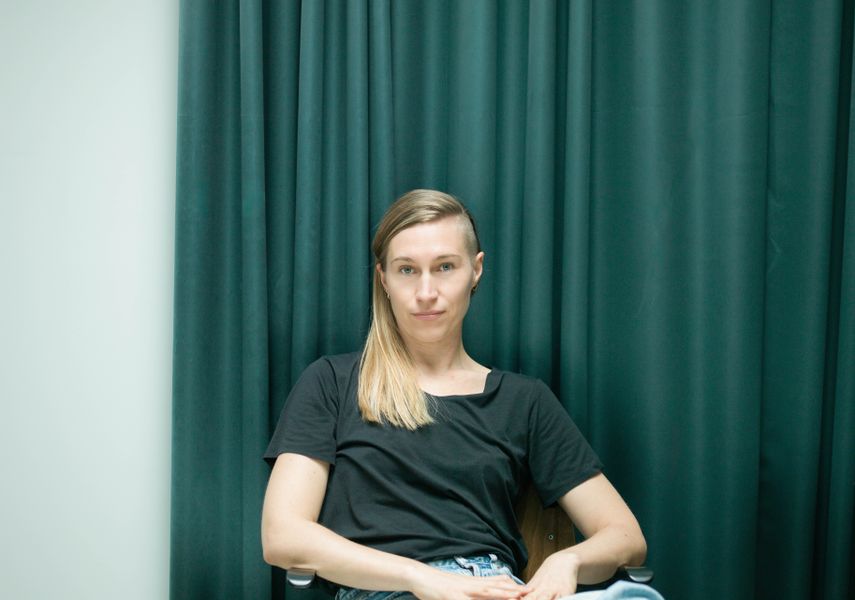A conversation with VIERNULVIER-resident Mette Ingvartsen
VIERNULVIER has quite a few residents: some are temporarily working in our halls and studios, while others, like our house artists, we support for several years and you see them regularly returning in the program. Our house artists are Joshua Serafin, Mette Ingvartsen, Decoratelier/Jozef Wouters, Damaged Goods/Meg Stuart, not standing/Alexander Vantournhout, Laura Nsengiyumva, laGeste, and Kabinet K. Read more about the residency program at viernulvier.gent/residents.
We visited VIERNULVIER house artist Mette Ingvartsen during the rehearsals of ‘Delirious Night’ (to be seen at VIERNULVIER on October 1 & 2). The Danish choreographer and dancer has been living and working in Belgium for a long time. She gives us insight into her work and sources of inspiration.
Are you still performing on stage?
Yes, I actually still do both: dancing and choreographing. Over the past twenty years, I have created about seven solos, so I have quite a bit of stage experience. But my performances have gradually become larger, which means I often stand on the sidelines. In the past, I used to perform on stage in group pieces, but lately, I have been stepping back more, simply because the work requires a lot of framing. Still, I enjoy doing both.
What are your biggest sources of inspiration?
My work often starts from social or political questions. That is usually my approach, whether I am dancing or choreographing. But I am also very interested in philosophy and theory – I read a lot and enjoy it. Sometimes I see something in society that triggers me, and then I try to understand what that has to do with me. Other times, I start from something very personal, and then I ask myself: is this something that others feel too? Very often, yes.
How does that translate on stage? Is there a typical ‘Mette style’ that exists?
If there is something that characterizes my work, it is the way of thinking: conceptual, exploratory. But I also love experimenting a lot. I have created a piece with trampolines, one with skaters and roller skaters, with staged fighting, Lindy Hop, techno... I always try out new forms. What remains is that I start from questions about how we coexist, and how we can show that on stage.

Collectivity is anyway also important in my work. In my group projects, the question often revolves around: how are we together? How can we practice together in a way of living together that we do not yet know, but want to?
You often work in series, why is that?
I think that is my way of delving deeply into something for a long time. For example, I had a series that dealt with the representation of nature, ‘Artificial Nature’. In that, I explored what theater can mean in a world where nature is disappearing. Can theater then take the place of what it means for us to engage with nature? At that time, I worked a lot with materials, light, smoke, sound – even with non-human performers. But after five years, I felt it was time for something different. The subsequent series ‘The Red Pieces’ revolved more around sexuality, nudity, and the political tensions that come with it. One of those pieces, ‘21 Pornographies’, I made just before the #MeToo movement broke out. That kind of coincidental timing happens quite often: things I am working on suddenly resonate in society as well.
Your work is also personal?
Yes, often. Many of the things I work with – skate culture, techno parties – come from my own youth. But I always try to link that to something larger, something that also plays out collectively. Collectivity is important in my work anyway. In my group pieces, it often revolves around the question: how are we together? How can we practice a way of living together that we do not yet know, but want to? In ‘Skatepark’, for example, you see friendship, care, but also frictions and conflicts. But even in my solos, I seek the link to the bigger picture by involving the audience.
Are you going to make a solo soon?
Yes, I consciously alternate that. A solo gives me the space to explore, to tinker, to slow down. In larger productions, the time pressure is much greater. Then it is nice to have that freedom sometimes where you don’t have to deliver something immediately.
What can we expect first from ‘Delirious Night’?
For this show, I drew a lot of inspiration from medieval dance mania, where people spontaneously began to dance in public places. I immediately saw a link with illegal raves, where people organize a pop-up party in a forest or a meadow. A kind of mass movement that people cannot resist. A way to escape the societal crises we experience around us. Can a dance performance also be a place to escape from this? Together with musician Will Guthrie, I explore how we can evoke trance-like states with rhythm, repetition, and excess.
-
-
Wed 01.1020:00 - 22:00De Vooruit, GentTHEATERZAAL
Rang 1 Pay What You Can - Basic € 15,00 Pay What You Can - Standard € 20,00 Pay What You Can - Support € 25,00 -26 € 10,00 -
Thu 02.1020:00 - 22:00De Vooruit, GentTHEATERZAAL
Rang 1 Pay What You Can - Basic € 15,00 Pay What You Can - Standard € 20,00 Pay What You Can - Support € 25,00 -26 € 10,00
-


